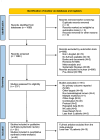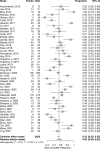CD19 CAR T cells for B cell malignancies: a systematic review and meta-analysis focused on clinical impacts of CAR structural domains, manufacturing conditions, cellular product, doses, patient's age, and tumor types
- PMID: 39174908
- PMCID: PMC11340198
- DOI: 10.1186/s12885-024-12651-6
CD19 CAR T cells for B cell malignancies: a systematic review and meta-analysis focused on clinical impacts of CAR structural domains, manufacturing conditions, cellular product, doses, patient's age, and tumor types
Abstract
CD19-targeted chimeric antigen receptors (CAR) T cells are one of the most remarkable cellular therapies for managing B cell malignancies. However, long-term disease-free survival is still a challenge to overcome. Here, we evaluated the influence of different hinge, transmembrane (TM), and costimulatory CAR domains, as well as manufacturing conditions, cellular product type, doses, patient's age, and tumor types on the clinical outcomes of patients with B cell cancers treated with CD19 CAR T cells. The primary outcome was defined as the best complete response (BCR), and the secondary outcomes were the best objective response (BOR) and 12-month overall survival (OS). The covariates considered were the type of hinge, TM, and costimulatory domains in the CAR, CAR T cell manufacturing conditions, cell population transduced with the CAR, the number of CAR T cell infusions, amount of CAR T cells injected/Kg, CD19 CAR type (name), tumor type, and age. Fifty-six studies (3493 patients) were included in the systematic review and 46 (3421 patients) in the meta-analysis. The overall BCR rate was 56%, with 60% OS and 75% BOR. Younger patients displayed remarkably higher BCR prevalence without differences in OS. The presence of CD28 in the CAR's hinge, TM, and costimulatory domains improved all outcomes evaluated. Doses from one to 4.9 million cells/kg resulted in better clinical outcomes. Our data also suggest that regardless of whether patients have had high objective responses, they might have survival benefits from CD19 CAR T therapy. This meta-analysis is a critical hypothesis-generating instrument, capturing effects in the CD19 CAR T cells literature lacking randomized clinical trials and large observational studies.
Keywords: 4-1BB; CAR T cell dose; CAR T cells manufacturing conditions; CD28; CD8; Clinical response CAR T cells; Costimulatory domain; Hinge; Transmembrane.
© 2024. The Author(s).
Conflict of interest statement
The authors declare no competing interests.
Figures



Similar articles
-
Bispecific anti-CD20, anti-CD19 CAR T cells for relapsed B cell malignancies: a phase 1 dose escalation and expansion trial.Nat Med. 2020 Oct;26(10):1569-1575. doi: 10.1038/s41591-020-1081-3. Epub 2020 Oct 5. Nat Med. 2020. PMID: 33020647 Clinical Trial.
-
Treatment of patients with relapsed or refractory CD19+ lymphoid disease with T lymphocytes transduced by RV-SFG.CD19.CD28.4-1BBzeta retroviral vector: a unicentre phase I/II clinical trial protocol.BMJ Open. 2019 May 19;9(5):e026644. doi: 10.1136/bmjopen-2018-026644. BMJ Open. 2019. PMID: 31110096 Free PMC article. Clinical Trial.
-
The efficacy and safety of anti-CD19/CD20 chimeric antigen receptor- T cells immunotherapy in relapsed or refractory B-cell malignancies:a meta-analysis.BMC Cancer. 2018 Sep 26;18(1):929. doi: 10.1186/s12885-018-4817-4. BMC Cancer. 2018. PMID: 30257649 Free PMC article.
-
The efficacy of anti-CD19 chimeric antigen receptor T cells for B-cell malignancies.Cytotherapy. 2019 Jul;21(7):769-781. doi: 10.1016/j.jcyt.2019.04.005. Epub 2019 May 31. Cytotherapy. 2019. PMID: 31160157
-
Efficacy and safety of adoptive immunotherapy using anti-CD19 chimeric antigen receptor transduced T-cells: a systematic review of phase I clinical trials.Leuk Lymphoma. 2013 Feb;54(2):255-60. doi: 10.3109/10428194.2012.715350. Epub 2012 Sep 8. Leuk Lymphoma. 2013. PMID: 22897728
Cited by
-
Advancing CAR-based cell therapies for solid tumours: challenges, therapeutic strategies, and perspectives.Mol Cancer. 2025 Jul 7;24(1):191. doi: 10.1186/s12943-025-02386-8. Mol Cancer. 2025. PMID: 40624498 Free PMC article. Review.
-
Efficacy and safety of CD19 combined with CD22 or CD20 chimeric antigen receptor T-cell therapy for hematological malignancies.Front Immunol. 2025 May 13;16:1577360. doi: 10.3389/fimmu.2025.1577360. eCollection 2025. Front Immunol. 2025. PMID: 40433368 Free PMC article.
-
Going viral: targeting glioblastoma using oncolytic viruses.Immunother Adv. 2025 Jul 25;5(1):ltaf024. doi: 10.1093/immadv/ltaf024. eCollection 2025. Immunother Adv. 2025. PMID: 40717958 Free PMC article. Review.
References
-
- Kawalekar OU, O’Connor RS, Fraietta JA, Guo L, McGettigan SE, Posey AD Jr., Patel PR, Guedan S, Scholler J, Keith B, et al. Distinct signaling of Coreceptors regulates specific metabolism pathways and impacts Memory Development in CAR T cells. Immunity. 2016;44(2):380–90. 10.1016/j.immuni.2016.01.021 - DOI - PubMed
-
- Mohty M, Gautier J, Malard F, Aljurf M, Bazarbachi A, Chabannon C, Kharfan-Dabaja MA, Savani BN, Huang H, Kenderian S, et al. CD19 chimeric antigen receptor-T cells in B-cell leukemia and lymphoma: current status and perspectives. Leukemia. 2019;33(12):2767–78. 10.1038/s41375-019-0615-5 - DOI - PubMed
Publication types
MeSH terms
Substances
Grants and funding
LinkOut - more resources
Full Text Sources
Research Materials

